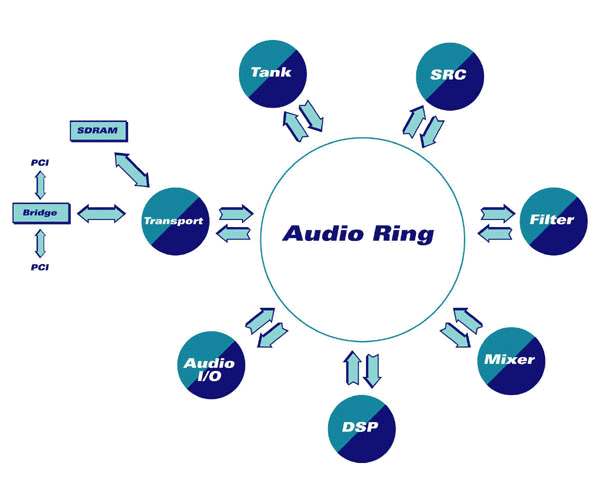Creative X-Fi: A New World of Sound
A New Architecture: Audio Ring
X-Fi is not just a new circuit - that's no big deal, as new circuits appear regularly. Unlike traditional sound processing circuits, which have a fixed sequential architecture, X-Fi's Audio Ring architecture allows processing sequences to be reconfigured to suit the task at hand. X-Fi has a naturally modular architecture, with each module communicating via the Audio Ring - a kind of bus that accepts up to 4,096 audio channels.
The Audio Ring bus is not really comparable to that of a professional mixing board, either, because it handles significantly more functions - such as communication with the PC's memory using a wider bandwidth than the PCI interface can handle.
The next table shows the distribution of processing power among the main modules that make up the X-Fi circuit. We'll come back to certain ones in detail, such as the Sample Rate Converter (SRC), a new technology that, as you can see, takes up the lion's share of the processing power.
| X-Fi Raw Data Path MIPs | |
|---|---|
| SRC | 7310 |
| Filter | 200 |
| Mixer | 1210 |
| Tank | 440 |
| DSP | 1180 |
| Total | 10340 |
In practice, users of an X-Fi card are offered three configurations, corresponding to the three main types of use: Gaming, Entertainment, and Creation. The table below sums up the basic capabilities of each configuration, which we'll discuss in detail when we look at drivers and software.
Another point to stress is that the X-Fi circuit is not tied to the PCI bus, so it can be used in equipment using the USB, FireWire, or PCI Express interfaces. Special versions will probably also be employed in consumer electronics equipment.
Get Tom's Hardware's best news and in-depth reviews, straight to your inbox.

